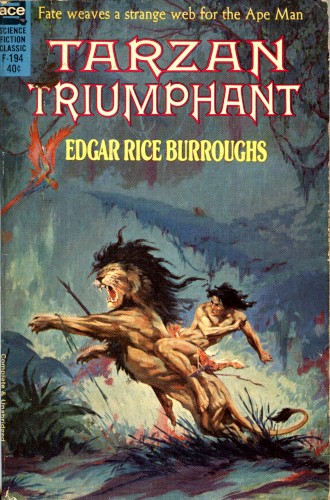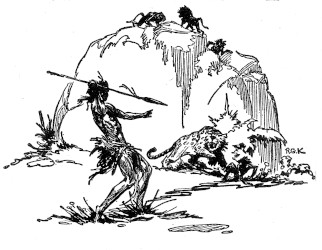
TARZAN TRIUMPHANT
By EDGAR RICE BURROUGHS

ACE BOOKS, INC.
1120 Avenue of the Americas
New York 36, N.Y.
This Ace edition follows the text of the first hard-cover book
edition, originally published in 1932.
Cover art and title-page illustration by Roy Krenkel, Jr.
Printed in U.S.A.
LOST PEOPLE IN A TRACKLESS JUNGLE
How strange the ways of fate—to bring together such an odd assortmentof people to face the perils of the darkest continent!
"Gunner" Patrick, once a gunman, now fleeing from the perils ofChicago gangland, in the company of unsuspecting.
Lafayette Smith, a brilliant geologist, looking for rocks, butinstead finding.
Lady Barbara Collis, aviatrix, lost in the wilds of a hidden valleywith only.
Jezebel, a beautiful young Midianite, whose people think nothing ofburning strangers alive.
Only fate could cause these various destinies to twine and intertwine,and only Tarzan, Lord of the Jungle, can rescue them from thesavagery of Africa and the treachery of men.
PROLOGUE
Time is the warp of the tapestry which is life. It is eternal,constant, unchanging. But the woof is gathered together from the fourcorners of the earth and the twenty-eight seas and out of the air andthe minds of men by that master artist, Fate, as she weaves the designthat is never finished.
A thread from here, a thread from there, another from out of the pastthat has waited years for the companion thread without which thepicture must be incomplete.
But Fate is patient. She waits a hundred or a thousand years tobring together two strands of thread whose union is essential to thefabrication of her tapestry, to the composition of the design that waswithout beginning and is without end.
A matter of some one thousand eight hundred sixty-five years ago(scholars do not agree as to the exact year), Paul of Tarsus sufferedmartyrdom at Rome.
That a tragedy so remote should seriously affect the lives anddestinies of an English aviatrix and an American professor of geology,neither of whom was conscious of the existence of the other at the timethis narrative begins—when it does begin, which is not yet, since Paulof Tarsus is merely by way of prologue—may seem remarkable to us, butnot to Fate, who has been patiently waiting these nearly two thousandyears for these very events I am about to chronicle.
But there is a link between Paul and these two young people. It isAngustus the Ephesian. Angustus was a young man of moods and epilepsy,a nephew of the house of Onesiphorus. Numbered was he among the earlyconverts to the new faith when Paul of Tarsus first visited the ancientIonian city of Ephesus.
Inclined to fanaticism, from early childhood an epileptic, andworshipping the apostle as the representative of the Master on earth,it is not strange that news of the martyrdom of Paul should have soaffected Angustus as to seriously imperil his mental balance.
Conjuring delusions of persecution, he fled Ephesus, taking ship forAlexandria; and here we might leave him, wrapped in his robe, huddled,sick and frightened, on the deck of the little vessel, were it notfor the fact that at the Island of Rhodus, where the ship touched,Angustus, going ashore, acq